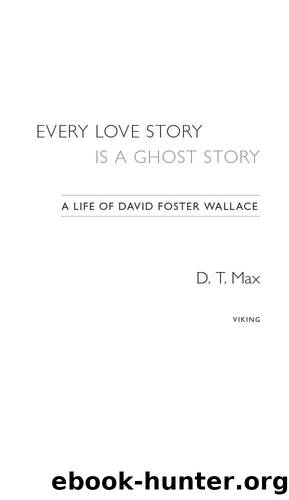Every Love Story Is a Ghost Story: A Life of David Foster Wallace by Max D. T

Author:Max, D. T. [Max, D. T.]
Language: eng
Format: epub
ISBN: 9781101601112
Publisher: Penguin Group
Published: 2012-08-29T20:00:00+00:00
Harris became an old heartthrob, someone who âworked detasseling summer corn with me in high school.â She was in real life neither âa Native Companion,â as Wallace called her in the article, nor a graduate of Urbana Highâthat was more Susie Perkins or his sister. And when it was time for Native Companion to speak, Wallace gave Harris the voice of the woman whose star still twinkled over his head. âOh for fuckâs sake,â Native Companion reproofs the upset Wallace after being exposed during the Zipper ride, âit was funâson of a bitch spun that car sixteen timesâ¦. Buy me some pork skins, you dipshit.â
Wallace took pleasure in writing the piece. For him, the challenge in nonfiction was always what to leave out, but the state fair was a subject with natural boundaries and one that invited a light style that moved to bigger, more serious questions: What made Americans so obsessed with entertainment? Could whatever void they were trying to plug ever be filled? It helped that at the fair the people were gluttons and the animals miserable. It was another chance to assert the thesis of Infinite Jest, to anatomize the unending American quest for distraction, the failure of his countryman, as Remy Marathe, the Quebecois terrorist agent,2 says in Infinite Jest, âChoose with care. You are what you love. No?â3
Shortly after, Wallace sent in his long draft, several times the possible length of the piece. Colin Harrison, the editor, set to work cutting with Wallace. The process reminded Harrison of a game of tennis, the prospective edits turning into âhereâs-what-I-think, what-do-you-think rallies that sometimes went on for many minutes,â as he wrote in a remembrance, and ended with a cut accepted or partially accepted or traded off for a cut somewhere else. Wallace was strategic and aggressive, but when he lost a point, he moved on. Together they shortened the piece almost by half. Harrison, an experienced editor, was aware that Wallace sometimes embellished. At one point, he asked Wallace if a vial of crack that Wallace reported had fallen out of the pocket of a young man on the Zipper had really âdirect-hit a state trooper alertly eating a Lemon Push-Up on the midway below.â Wallace was coy. âIâm going to give you this one,â Harrison remembers saying. He wanted Wallace to pursue his comic vision. âI drank the Kool-Aid,â he recalls. So if Wallace wrote it, it aided the narrative energy, and could not be disproven when the piece was fact-checked, it could run.4, 5
The article, which came out the next July, also unveiled a new Wallace to readers, neither the creator of elaborate fictional worlds nor the Cavellian essayist but someone more of a piece with the characters in his fiction. At one point, Wallace describes being too afraid to go into the Poultry Building, explaining that as a child he had once been attacked by a chicken âwithout provocation, flown at and pecked by a renegade fowl, savagely, just under the right eye.â
Download
This site does not store any files on its server. We only index and link to content provided by other sites. Please contact the content providers to delete copyright contents if any and email us, we'll remove relevant links or contents immediately.
I Have Something to Say by John Bowe(3286)
What Happened to You? by Oprah Winfrey(1480)
Doesn't Hurt to Ask by Trey Gowdy(1402)
Einstein: His Life and Universe by Walter Isaacson(1320)
Solutions and Other Problems by Allie Brosh(1035)
Disloyal: A Memoir by Michael Cohen(1025)
American Dreams by Unknown(862)
Don't Call it a Cult by Sarah Berman(843)
Infinite Circle by Bernie Glassman(831)
Home for the Soul by Sara Bird(814)
Group by Christie Tate(812)
Talk of the Ton by unknow(736)
The Silent Cry by Cathy Glass(684)
Total F*cking Godhead by Corbin Reiff(666)
Severed by John Gilmore(656)
Searching for Family and Traditions at the French Table by Carole Bumpus(650)
The Battle of Mogadishu by Matt Eversmann & Dan Schilling(615)
Before & Laughter by Jimmy Carr(607)
Things I Wish I Knew Before My Mom Died by Ty Alexander(601)
